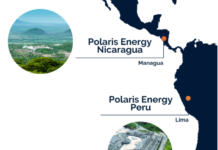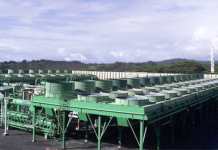Tom Konrad, CFA
The market for Organic Rankin Cycle geothermal turbines has become competitive.
In my October 2010 profile of geothermal industry leader Ormat Technologies (ORA), I quoted a conversation I’d had with a Geothermal Energy Association (GEA) representative in 2006, where she told me that Ormat stood head and shoulders above all the other geothermal players.
As the only truly vertically integrated geothermal developer, with in-house exploration, drilling, turbine technology, and operations, Ormat is still unique among geothermal companies. But not too long ago their Organic Rankin Cycle turbines (which they call Ormat Energy Converters, OEC) did not have much serious competition when it came to exploiting relatively low temperature (liquid water) resources.
Organic Rankine Cycles
The Organic Rankine Cycle (ORC) is also called Binary cycles because there are two fluids involved: a working fluid as well as the geothermal fluid which provides the heat. “Organic” refers to the fact that the working fluid is usually an organic liquid such as isopentane or one of several refrigerants. The working fluid is chosen so that it has a much lower boiling point than water, and so it is in gaseous phase and can drive a turbine when the heat source is too cool to boil water. ORCs are also often used as bottoming units to generate power from the waste heat from conventional turbines at higher-temperature geothermal resources, or from the waste heat from other types of industrial waste heat.
Ormat’s over 300 million hours of turbine operations is still unmatched by other companies’ technology, but several rivals now have enough history in the field and financial strength to provide product guarantees so that geothermal developers and their banks can feel confident that the projects will be reliable and durable enough to lend money against.
The Competition
Mark Taylor, the lead analyst for geothermal and CCS at Bloomberg New Energy Finance gave an overview of the market for geothermal turbines at the GEA Finance Forum in New York on February 9th. Binary turbines are still only a small fraction of the market, with the majority of installed turbines being larger conventional steam turbines, with leading suppliers being Toshiba, Mitsubishi, and Fuji. Binary plants are only about 12% of the market by installed capacity, and Ormat’s OECs are installed in 92% of these. However, in terms of recent installations, Ormat has only about half of the market for binary plants.
One sign of the increased competition was Ormat’s deal with Nevada Geothermal Power (NGLPF.OB, NGP.V) to develop the latter’s Crump Geyser property. Under the deal, Ormat will earn a 50% stake in the property by doing all of the development work, and paying for most of it, in addition to providing enough financing to Nevada Geothermal that the latter will not need to pay anything more out of pocket to develop the property. According to John McIlveen of Jacob Securities, a significant factor in Ormat’s willingness to do this deal was the assurance that Ormat would be the contractor on the project.
While Ormat’s competitors cannot offer drilling services as well as construction and financing, many geothermal developers are comfortable using their own drilling contractors. The two competitors to present at the forum both appeared to me to have compelling offerings.
One turbine manufacturer that presented was Turbine Air Systems (TAS). TAS is headquartered in Houston, with several offices in the Middle East and South East Asia. Unlike the other manufacturers, TAS manufactures their turbines in their factory, and move them on site in a minimum of modules, which they claim saves time and on-site labor during installation. Another way TAS saves time for developers is by working only with nonflammable refrigerants, which can simplify the permitting process. Perhaps more importantly, TAS has the financial strength to provide vendor financing, as they did for US Geothermal’s (HTM) San Emidio property.
The other major turbine supplier to present was Pratt & Whitney, a division of United Technologies (UTX). Pratt & Whitney purchased Turboden in 2009 adding full size binary turbines to their small-scale mass produced PureCycle offering (I discussed PureCycle in more depth in my 2007 overview of Geothermal power.) Turboden is a European supplier of ORC turbine with 30 years experience and 174 plants installed mostly in Germany, Austria, and Italy. Most of their existing plants run off biomass and waste heat, but they have made sales in geothermal, in Germany, Austria, and France. Despite Turboden’s limited experience in geothermal markets, Pratt & Whitney’s strong balance sheet and deep experience in power generation markets mean the company has to be considered a serious contender for geothermal power plants, and their competitive offerings are likely to grow stronger as they develop a longer track record in geothermal power generation.
Implications for Investors
For Ormat, the emergence of serious competition for ORC power plants may reduce potential future growth in their product segment. This may not slow the company’s overall growth much, especially since the product segment has recently been lagging anyway, mostly due to many developers’ difficulties in obtaining financing. While the financing problem for geothermal developers is easing, some of the rebounding market is likely to be captured by other turbine suppliers. Ormat is likely to be increasingly reliant on its electricity generation segment, which may put an upper limit on how quickly the company can grow in future years. In my recent profile of Ormat, I concluded that it was difficult to justify the company’s valuation even with the consensus five year expected growth of 29% which was expected by analysts when I wrote that article in October.
If anything, the newly competitive turbine market will reduce Ormat’s potential growth rate. Apparently other analysts agree, because the current consensus is now reported as 9.8%, a number I feel is much more reasonable. However, at the current stock price of $29.32, Ormat’s forward P/E is 30.2, giving a Price/Earnings Growth ratio of a stratospheric 3.63.
For geothermal
developers, the advent of serious competition to supply binary turbines is good news, because it means that vendors will compete for geothermal developers’ business, meaning that more attractive deals will be on offer. I continue to add to my holdings of Magma Energy Corp. (MXY.TO, MGMXF.PK), Nevada Geothermal Power (NGLPF.OB, NGP.V), Ram Power Corp. (RPG.TO, RAMPF.PK), and US Geothermal (HTM).
DISCLOSURE: Long MGMXF,NGLPF, RAMPF, and HTM.
DISCLAIMER: The information and trades provided here are for informational purposes only and are not a solicitation to buy or sell any of these securities. Investing involves substantial risk and you should evaluate your own risk levels before you make any investment. Past results are not an indication of future performance. Please take the time to read the full disclaimer here.








Tom … I’ve owned NGLPF shares for a couple of years, and they’ve been rangebound forever after dropping slowly and painfully from $1.27. Is there some sort of trigger event I should be looking for? Seems like their projects are perking along, so I’m perplexed, and a bit anxious. Cheers, Pat
Competition is always a good thing. In this case, it’s especially good for the environment.
Pat… I’ve also owned NGP for years. Part of the problem was the need to do extra work to bring Faulkner 1 up to expected capacity right in the middle of the financial crisis… they had to pay over the odds for debt to do that, and that is money that we as shareholders will never see again.
Right now, I think the company is too cheap given its assets, but I don’t know what might change the markets’ mind about the company… but I;m not thinking of selling.